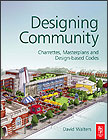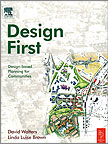
Designing Community
Charrettes, Masterplans and Form-based Codes
David Walters
2007 Architecture Press
Planning and Urban Design:
The role of urban design in reformulating planning practice.
This is a book for architects, landscape architects, planners and students of all three professions. It aims to show planners how urban design is once again central to their profession, and it seeks to inform architects and landscape architects about the public policy and theory-based content of planning that governs their work as urban designers. As a lens to bring these issues into focus, the book utilizes comparative studies of British and American theory and practice about urban design and planning, for the two countries have many urban issues in common: the legacy of failed modernist architecture and planning concepts, the regeneration of central cities, the battle against urban poverty and the crisis of affordable housing, and improving the dismal design standards of much suburban development are just four of the most obvious ones. But for all these professional similarities, the political context in which architects, urban designers and planners work in the two countries is radically different, both structurally in terms of the political framework for planning in a democracy, and ideologically regarding the relative roles of the state and private capital. As an English architect working in America, the author has first-hand experience of both sets of conditions, and is able to examine issues ‘from the inside,’ using his own work in America as case studies where appropriate.
But first, a word about the title: Designing Community. This places equal emphasis on design (in this context conceptualized as the act of creating city spaces as sites and containers of human activity) and on the concept of community. Community is a term loosely bandied about by everybody from politicians to planners and urban designers to developers to members of communities themselves, and it means different things to different people. At the most minimal level ‘community’ is a term coined by developers to cast a superficial romantic gloss over their latest mass-produced subdivisions or housing estates, usually called into being by photographs of happy families in front of their new homes. A particularly egregious use of the term could be found in August 2006 in a developer’s advertisement for a subdivision amidst the sprawl that surrounds Charlotte, North Carolina, in the USA, which offered a ‘new way of life’ in a ‘full brick community.’ For British readers, ‘full brick’ means a housing estate where the detached houses are built of light timber frame faced with brick on all sides instead of simply a veneer on the front. Brick is a sign of status in American house building, as opposed to cheaper vinyl siding, and here the potentially rich concept of community is reduced merely to a marketing ploy of snobbish aesthetics.
To residents of a neighborhood, ‘community’ is often a way of defining their shared values (or shared income levels) as distinct and separate from adjacent areas, and the term may be used for either positive or exclusionary purposes. To ethnic minorities ‘community’ can be a rallying cry of unity and identity linked to a specific locality, or it can become an element in a political ideology, as witnessed by British Prime Minister Tony Blair’s use of the term in a speech in January 1999:
"A modern idea of community is one which applauds and nurtures individual choice and personal autonomy and which recognizes the irreducible pluralism of modern society." (Holden and Iveson: 61)
This idea of community as a dialectic between the individual and society, especially when linked to physical space in the city, has a long lineage in planning and urban design practice, and this book examines relationships between physical urban form and the social activities and attitudes of citizens as they affect, guide and challenge the work of design and planning professionals in Britain and America. The role of public participation in planning and urban design is crucial in this regard. The days of the detached ‘expert’ handing down his plan to a grateful and awed public are long gone, and deservedly so. However, in their place are confused and often bruising debates between planners, politicians, designers and the public about priorities for urban growth or infill development, open space, traffic, schools, parks, affordable housing and a host of other urban issues. This book describes and highlights some effective techniques using the design ‘charrette’ format of public involvement in planning decisions. The American usage of this term is roughly equivalent in the UK to ‘action planning,’ and ‘planning weekends,’ and is most directly equated to the process of ‘Enquiry by Design’ promulgated by the Prince of Wales’ Foundation. All the terms mean broadly the same thing: intensive, inclusive workshops, lasting several days, that involve a variety of professionals, elected officials and citizens from the community working together to hammer out concrete design proposals, or master plans for future action.
By pairing the two words ‘Designing’ and ‘Community,’ I mean to highlight intersections between the act of physical placemaking and larger issues of society and culture. The book’s subtitle, Urban Design, Planning and Form-based Codes, identifies a secondary juncture between planning and architecture as the site of a revived and important professional discourse about urbanism and methods of creating and regulating development to promote good quality design. After several decades of separation, in both theory and practice, the two professions are once more converging, led in part by architects and urban designers who have restructured the leading edge of planning practice around theories and principles of physical urban design. In Britain this is part of structured government policy, while in the USA these changes have evolved through the professional activism of architects and planners themselves, often in the face of government neglect or opposition.
This book also builds upon a few basic presumptions about urbanism. First and foremost is that the form of physical places needs to be considered long before conventional planning standards about uses of space and buildings. Buildings and urban spaces last a lot longer than do fleeting patterns of use, which might change every year or two, or several times within each generation. In everyday life, old buildings are retrofitted for new uses and comparatively new buildings can be left vacant after only a few years; whole neighborhoods cycle through decline and decay, followed by periods of renewal and gentrification by new people with fresh priorities and different lifestyles. For the last fifty years, in the USA especially, understanding this importance of urban form has been exactly what planning has not been about. Considerations of use have been paramount, to the exclusion of almost everything else; America is cluttered with examples where the zoning codes that control development have made the urban form of traditional American towns illegal by outlawing the commonsense practice of mixing uses within the same building, and by forcing single-use buildings to space themselves widely apart. By contrast, the new form-based American zoning codes discussed in this book put form first and use second.
The destructive capacity of conventional zoning is a familiar story, more pertinent in the USA than Britain, where the ‘townscape’ school of civic design and the tradition of ‘town planning’ with its physical design implications never quite faded from view. But this traditional emphasis on urban design in British planning has been markedly lacking in most new developments constructed around the edges of British towns and cities since the 1950s, and especially since the 1980s. Part of the reasoning behind the British government’s recent push for design codes to become an integral part of the planning and development system has been the desire to improve the poor quality of design that has become part of the normative British suburban experience. In this regard, Britain and America have much in common, and can usefully learn from each other’s experience in attempting to reformulate their planning systems around concepts of good urbanism.

